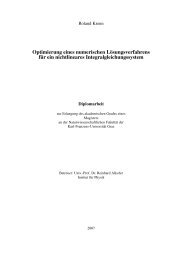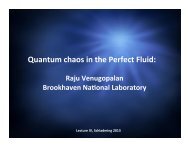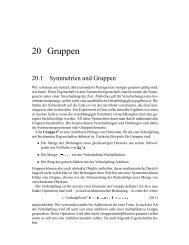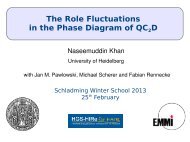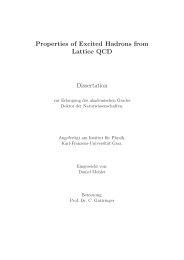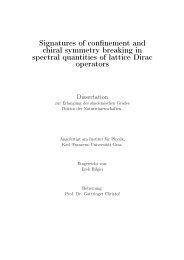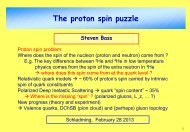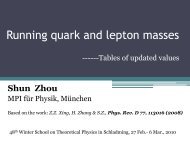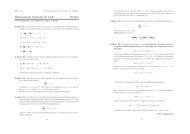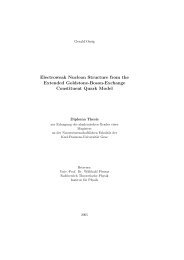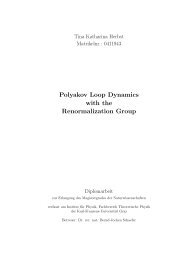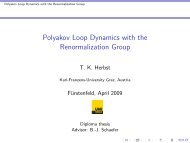The QCD Quark Propagator in Coulomb Gauge and - Institut für Physik
The QCD Quark Propagator in Coulomb Gauge and - Institut für Physik
The QCD Quark Propagator in Coulomb Gauge and - Institut für Physik
You also want an ePaper? Increase the reach of your titles
YUMPU automatically turns print PDFs into web optimized ePapers that Google loves.
Chapter 6. Nucleon Form Factors <strong>in</strong> a Covariant Diquark-<strong>Quark</strong> model 69<br />
6.4.1 Coupl<strong>in</strong>g to the quark<br />
In this section we deal with diagram 1. <strong>The</strong> one-body term is expressed as<br />
(<br />
)<br />
Jµ qu = S(p q )ˆΓ qu<br />
µ (p q; k q )S(k q ) ∆ 0+ (k s ) + ∆ 1+ (k s ) (2π) 4 δ 4 (p − k − ˆηQ) , (6.54)<br />
qu<br />
where ˆΓ µ (p q; k q ) = Q q Γ µ (p q ; k q ), with Q q = diag[2/3, −1/3] be<strong>in</strong>g the quark electric<br />
charge matrix, <strong>and</strong> Γ µ (p q ; k q ) is given <strong>in</strong> equation(6.57).<br />
Here <strong>and</strong> <strong>in</strong> the diagrams 2 <strong>and</strong> 4 the denotation<br />
k q = ηP + k , p q = ηP ′ + p ,<br />
k d = ˆηP − k , p d = ˆηP ′ − p ,<br />
(6.55)<br />
with η + ˆη = 1 is used. <strong>The</strong> results reported were obta<strong>in</strong>ed with η = 1/3, which provides<br />
a s<strong>in</strong>gle quark with one-third of the baryon’s total momentum, but, as our approach is<br />
manifestly Po<strong>in</strong>caré covariant, the precise value is immaterial. Nevertheless, numerical<br />
results converge more quickly with this natural choice.<br />
This represents the photon coupl<strong>in</strong>g directly to the byst<strong>and</strong>er quark <strong>and</strong> is obta<strong>in</strong>ed<br />
explicitly from the equations (6.52) <strong>and</strong> (6.54). It is a necessary condition for current<br />
conservation that the quark-photon vertex satisfy the Ward-Takahashi identity:<br />
Q µ iΓ µ (l 1 , l 2 ) = S −1 (l 1 ) − S −1 (l 2 ) , (6.56)<br />
where Q = l 1 − l 2 is the photon momentum flow<strong>in</strong>g <strong>in</strong>to the vertex. S<strong>in</strong>ce the quark<br />
is dressed the vertex is not bare; i.e., Γ µ (l 1 , l 2 ) ≠ γ µ . It can be obta<strong>in</strong>ed by solv<strong>in</strong>g an<br />
<strong>in</strong>homogeneous Bethe-Salpeter equation, which was the procedure adopted <strong>in</strong> the DSE<br />
calculation that successfully predicted the electromagnetic pion form factor [MT00]. However,<br />
s<strong>in</strong>ce we have parametrised S(p), we use the Ball-Chiu construction of the vertex<br />
[BC80]<br />
iΓ µ (l 1 , l 2 ) = iΣ A (l 2 1, l 2 2) γ µ + 2k µ<br />
[<br />
iγ · kµ ∆ A (l 2 1, l 2 2) + ∆ B (l 2 1, l 2 2) ] ; (6.57)<br />
with k = (l 1 + l 2 )/2, Q = (l 1 − l 2 ) <strong>and</strong><br />
Σ F (l 2 1, l 2 2) = 1 2 [F(l2 1) + F(l 2 2)] , ∆ F (l 2 1, l 2 2) = F(l2 1 ) − F(l2 2 )<br />
l 2 1 − l2 2<br />
, (6.58)<br />
where F = A, B, i.e. the scalar functions <strong>in</strong> equation(6.29). It is critical that Γ µ <strong>in</strong><br />
equation (6.57) satisfies equation (6.56) <strong>and</strong> very useful that it is completely determ<strong>in</strong>ed<br />
by the dressed-quark propagator. This ansatz has been used fruitfully <strong>in</strong> many hadronic<br />
applications [AS01]. Its primary defect is the omission of pion cloud contributions. But<br />
s<strong>in</strong>ce one of our goals is to draw attention to consequences of that omission, this fault is<br />
here<strong>in</strong> a virtue.



